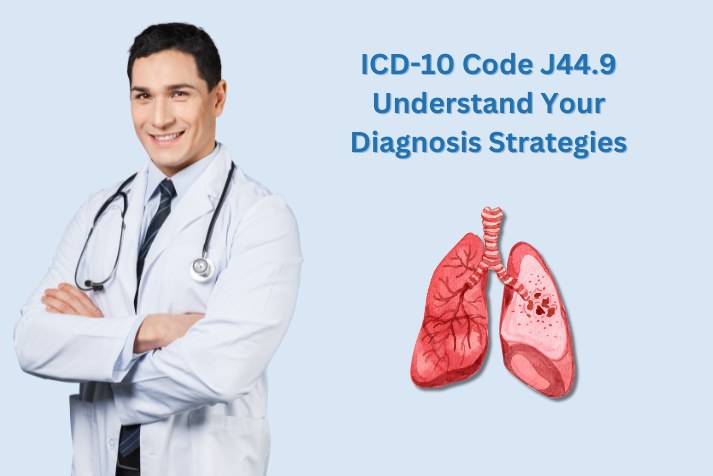As a healthcare provider it is necessary to understand the complexities of medical billing for Chronic Obstructive Pulmonary Disease (COPD), but understanding the J44.9 ICD-10 code is key to simplifying this process. The J44.9 code represents the diagnosis of unspecified COPD, a category that comprises a range of conditions affecting the lungs.
Healthcare providers and medical billing professionals must recognize when J99,9 is applicable, but by using of J44.9 code practitioners can avoid common billing errors and focus on delivering optimal patient care through this code.
Understanding COPD and Its ICD-10 Codes
This section provides an introduction to Chronic Obstructive Pulmonary Disease (COPD), highlighting its symptoms, treatment options, and the significance of accurate ICD-10 coding.
Identifying COPD: A Clinical Overview
- Describes COPD’s pathophysiology: Explains how COPD affects lung function, focusing on airflow obstruction and its long-term effects.
- Highlights the criteria for diagnosing COPD: Discusses the use of spirometry to measure lung function and confirm a diagnosis of COPD, emphasizing the value of this test in detecting the disease early.
- Emphasizes the importance of early detection: Underlines how early diagnosis can lead to better management of COPD, potentially slowing disease progression.
Key Symptoms and Diagnostic Criteria for COPD
- Lists common COPD symptoms: Details typical signs of COPD, such as persistent cough, difficulty breathing, and frequent respiratory infections, to aid in early recognition.
- Details of the diagnostic process: Outlines the steps healthcare providers take to diagnose COPD, including reviewing medical history, conducting physical exams, and performing diagnostic tests.
- Discusses the role of diagnostic criteria: Explains how these criteria help determine the severity of COPD, which is crucial for creating an effective treatment plan.
An Introduction to ICD-10 Coding for COPD
- Explains the structure of the ICD-10 coding system: Provides a brief overview of how ICD-10 codes are organized and why they’re essential for patient care and medical billing.
- Provides an overview of the codes related to COPD: Introduces various ICD-10 codes used for COPD, including J44.9, and explains their significance in medical documentation.
- Stresses the importance of accurate coding: Highlights how precise coding ensures appropriate treatment, billing, and reimbursement for healthcare services.
Decoding the J44.9 Diagnosis Code for COPD
Focuses on the specific ICD-10 code J44.9, detailing its application in diagnosing COPD without complications.
The Clinical Relevance of J44.9 in COPD Care
- Clarifies the specific conditions J44.9 represents: Discusses how J44.9 is used to indicate COPD cases without further specification, typically used when the patient’s COPD does not include acute exacerbations.
- Discusses its use in clinical documentation: Explores the implications of selecting J44.9 for patient records, and treatment plans, and how it impacts care management.
- Examines the implications for treatment decisions: Looks at how the choice of J44.9 affects the approach to treating COPD, including pharmacological and non-pharmacological interventions.
Comparing J44.9 with Other COPD Diagnosis Codes
- Compares J44.9 to other COPD-related ICD-10 codes: Analyzes how J44.9 is differentiated from codes specifying COPD with acute exacerbation or with chronic bronchitis, for example.
- Analyzes scenarios where different codes might be more appropriate: Provides examples of clinical situations that would warrant the use of COPD codes other than J44.9, offering insight into accurate coding practices.
- Illustrates the impact of code selection on treatment plans: Discusses how the choice of a specific COPD code can guide the management strategy, affecting medication, therapy, and monitoring.
Comprehensive Guide to COPD ICD-10 Codes
Offers an in-depth look at the range of ICD-10 codes related to COPD, including those for COPD with emphysema. It discusses the nuances of each code, providing insights into their correct application for accurate patient records and billing processes.
Detailed Analysis of COPD ICD-10 Coding
- Dives deeper into the complexity of COPD coding: Explores the granularity of COPD-related ICD-10 codes, explaining how they capture the disease’s severity, manifestations, and complications.
- Discusses the significance of accurately capturing the severity: Emphasizes the importance of detailed coding in reflecting the patient’s condition accurately, affecting treatment decisions and health outcomes.
- Highlights coding challenges: Addresses common challenges in COPD coding, such as distinguishing between different types and severities of the disease, and offers solutions to ensure accuracy.
Special Considerations for Coding COPD with Emphysema
- Addresses how to accurately code COPD cases with emphysema: Focuses on using specific ICD-10 codes to document cases where COPD is complicated by emphysema, ensuring that both conditions are accurately reflected in patient records.
- Explores the clinical distinction between COPD and emphysema: Clarifies the relationship between COPD and emphysema, discussing how emphysema is a specific form of COPD that affects the alveoli.
- Offers guidance on documenting coexisting conditions: Provides advice on how to accurately code when COPD and emphysema coexist, highlighting the need for precise documentation to support comprehensive patient care and accurate billing.
The Impact of Accurate COPD Coding on Medical Billing
Explores the direct relationship between precise COPD coding and the financial aspects of healthcare delivery. It covers the benefits of correct coding for repayment purposes and outlines common coding mistakes, offering strategies to avoid them.
Strategies for Enhancing Reimbursement through Accurate Coding
- Presents strategies to ensure coding accuracy: Offers practical tips for healthcare providers with actionable advice to improve the accuracy of their COPD coding.
- Discuss the importance of thorough documentation: Emphasizes the critical role of detailed and precise documentation of patient encounters, diagnostic tests, and treatment plans.
- Offers tips for staying updated with coding guidelines and payer policies: Points out the necessity for healthcare providers and medical billing professionals to stay informed about changes in coding guidelines and insurance payers policies.
Beyond J44.9: Related Codes and Their Importance
Explore discussion to include related diagnostic codes, such as those for shortness of breath (SOB) and chronic obstructive lung disease, demonstrating how they complement the COPD diagnosis and affect medical billing and patient care.
Expanding Diagnosis: Other COPD-Related ICD-10 Codes
- The broader range of ICD-10 codes for COPD: This emphasizes the variety of ICD-10 codes available to describe the full spectrum of Chronic Obstructive Pulmonary Disease, acknowledging that COPD can manifest in multiple forms and severities that require distinct codes beyond J44.9 for accurate representation.
- Highlighting code complementarity: It underlines the importance of using a combination of codes to capture the complete clinical picture of a patient’s COPD condition.
Coding for COPD Complications and Co-Morbidities
- Accurate coding for COPD complications: Discusses the critical role of precise ICD-10 coding in identifying and documenting complications that can arise from COPD, such as acute exacerbations.
- Importance of coding common co-morbidities: It highlights the necessity of documenting co-morbid conditions often seen in patients with COPD, including cardiovascular diseases or diabetes.
Future Trends in COPD Diagnosis and ICD-10 Coding
Anticipates changes in the landscape of COPD diagnosis and ICD-10 coding, emphasizing the importance of staying informed about updates.
Anticipating Technological Advances in COPD Diagnosis
- Integration of AI and machine learning: Discusses how the integration of artificial intelligence (AI) and machine learning technologies into diagnostic tools can enhance the accuracy and efficiency of COPD diagnoses, potentially leading to earlier detection and more personalized treatment plans.
- Development of non-invasive diagnostic techniques: Highlights the ongoing research and development of non-invasive methods for diagnosing COPD, such as advanced imaging technologies and breath analysis tests, which could improve patient comfort and compliance with diagnostic procedures.
Evolving Guidelines and Codes for COPD in ICD-10
- Updates to COPD classification and coding: Focuses on anticipated updates to COPD classification within the ICD-10 coding system, reflecting advancements in understanding the disease’s pathophysiology and treatment approaches.
- Training and education for healthcare professionals: Emphasizes the importance of ongoing training and education for healthcare professionals, including coders, clinicians, and administrative staff, to adapt to changes in COPD coding guidelines.
Final Thought
As we navigate the complexities of COPD diagnosis and the critical role of the J44.9 ICD-10 code, it’s clear that accurate coding is more than just a bureaucratic necessity—it’s a cornerstone of quality patient care and efficient healthcare management. Staying abreast of coding updates, embracing technological advancements, and ensuring thorough documentation are essential practices for healthcare professionals.




